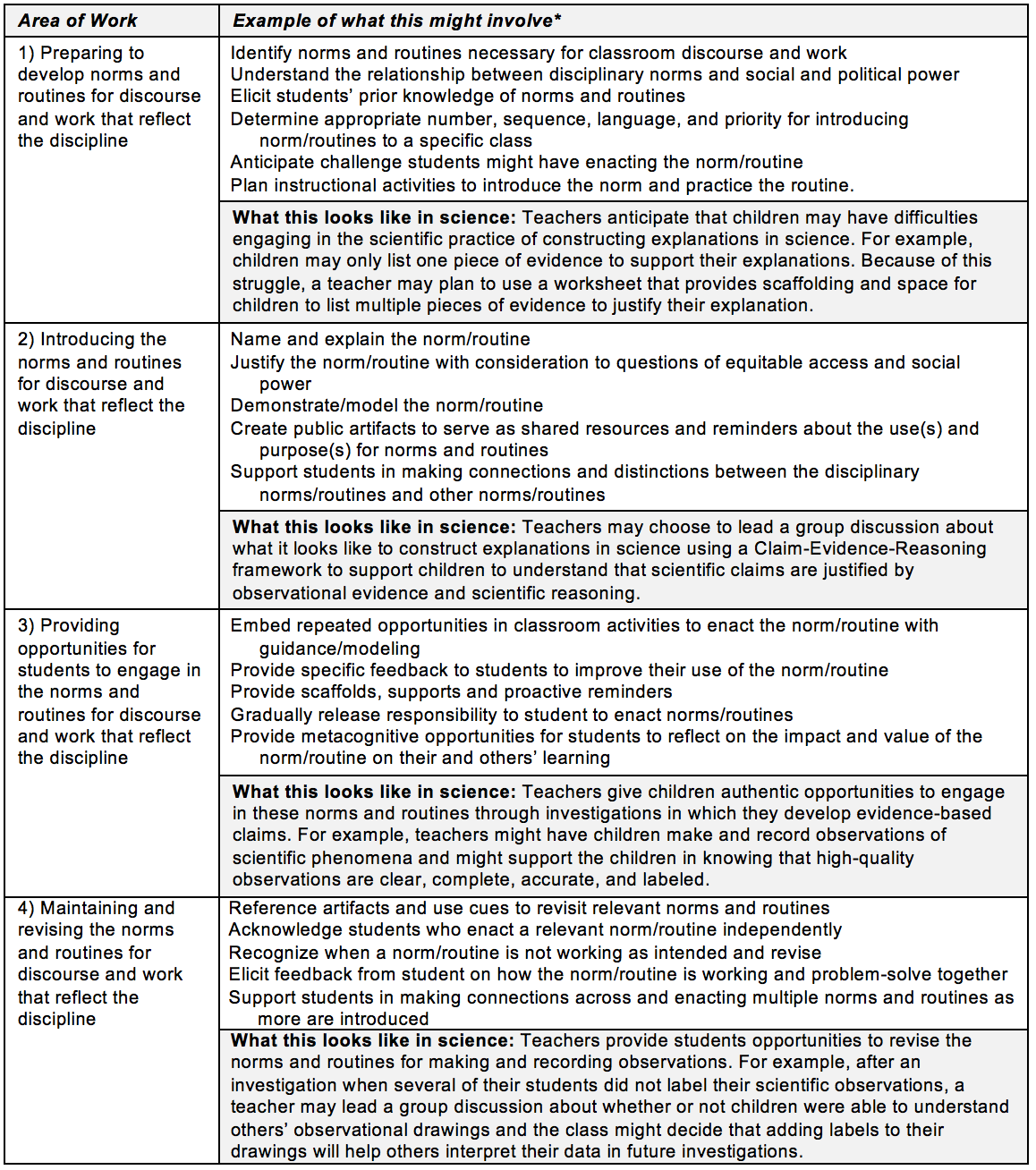What is implementing norms and routines for discourse in science?
As part of their practice, scientists rely on norms of thinking and discourse that enable them to pursue the work of the discipline and communicate with other scientists. In order to successfully engage students in the scientific practices, teachers need to support the development of these norms and routines in their classrooms. To do this effectively, teachers need to know (a) what the norms and routines of scientific discourse and work are, and (b) how to support the development of norms and routines in their classroom.
While the generic high-leverage practice describes the ways in which a teacher develops and reinforces these norms and routines in their classroom, we place emphasis on what those science-specific norms and routines for discourse and work are. In doing so, we draw on the disciplinary practices described in the Next Generation Science Standards and use the science and engineering practices as a guide for identifying and naming the norms and routines necessary for discourse and work in science.
Why work on implementing norms and routines for discourse in science?
The goal of science education extends beyond getting students to remember a set of facts about the natural world. Instead, students need to understand how knowledge is created in science, and the practices that scientists engage in (see NGSS). The scientific practices such as planning and carrying out investigations, engaging in argumentation and explanation construction, and communicating ideas represent fundamental ways in which people make sense of the world. By asking teachers to learn about and engage in the science practices and support students to do the same, teachers are afforded opportunities to attend closely to what students do and say. Working together with students to identify, name, and practice the norms and routines of science discourse and work, teachers can build on the relationships they have with their students and the relationships students have with the discipline (Bang et al., 2017).
How do teachers implement norms and routines for discourse?
Teachers can provide opportunities for students to learn norms and routines of discourse in science by engaging them in learning activities that mirror authentic scientific practice, such as constructing evidence-based explanations or engineering solutions to real-world problems. When students work together during these activities, they gain practice in actually enacting those norms and routines, rather than learning about them second-hand as a set of rules that scientists follow. One way teachers can support students to learn the norms and routines of scientific discourse and work is to assign roles for students to fill during scientific discussions and explorations. For instance, one student in the audience may be designated as the “evidence checker” whose job is to follow up on other students’ claims and ask for supporting evidence. This would help students learn that backing claims with evidence is a key part of scientific discourse, and the scaffold could be removed once they begin to do this on their own.
What are the elements of the practice?

*We have chosen to highlight the science practices of planning and carrying out investigations (with a focus on observations) and constructing explanations in science; however, teacher educators could choose any of the eight science practices from the Next Generation Science Standards as a focus when supporting novices to learn to develop norms and routines for discourse and work in science.
How do we support novice teachers to learn this practice?
In working on this practice in teacher education, we focus on helping novice teachers recognize the importance of implementing norms and routines for classroom discourse and work. Some novice teachers may not feel as comfortable with the science practices, and may have similar alternative explanations of how science is done as children do. Supporting novice teachers in anticipating these ideas and potential areas of struggle students may have when engaging in science practices is important. Doing so encourages a deeper understanding of the science practices they are asking students to engage in and can boost confidence in enactment by helping them to envision student successes and missed opportunities.
Novice teachers also typically have difficulty knowing how to identify, name, and provide students with authentic opportunities to engage in the science practices. We support them in this area by providing them with examples of how a teacher might identify and name the norms and routines for discourse and work in science. These activities provide concrete examples of how to implement norms and routines that can be adapted for different instructional purposes or simply used as is.
We also work with our novice teachers on designing tasks that give students authentic opportunities to share their ideas about the scientific practices and then have opportunities to repeatedly engage in the science practices through investigation-based lessons. We do this by supporting novice teachers to use the EEE+A framework to develop investigations that require students to engage with phenomena and come up with their own explanations based on the data they collect.